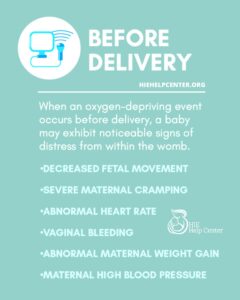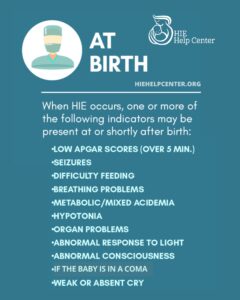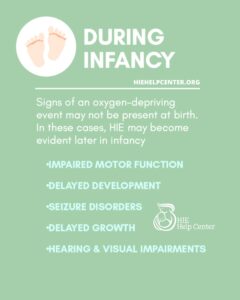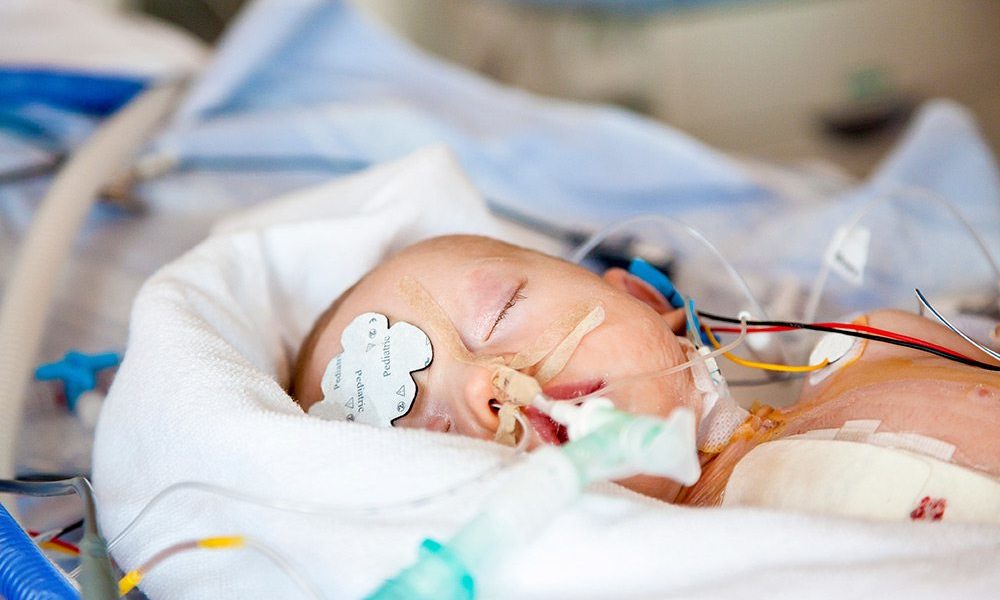The signs and symptoms of hypoxic-ischemic encephalopathy (HIE) can be divided into three groups:
- HIE signs that appear before or during birth
- HIE signs in the neonatal period (shortly after birth)
- HIE signs that appear later in infancy or childhood
It is essential that physicians recognize the signs and symptoms of HIE occurring before or shortly after birth. This is because therapeutic hypothermia, the only established treatment that can prevent or minimize permanent brain damage from HIE, must be administered shortly after the oxygen deprivation occurs. Current guidelines dictate that this therapy be given within six hours of the hypoxic-ischemic (oxygen-depriving) event. In many cases, this means within six hours of birth (1).
Signs and symptoms of HIE before birth
When an oxygen-depriving event occurs before delivery, a baby may exhibit noticeable signs of distress from within the womb. These signs may indicate that a pregnancy requires immediate intervention such as intrauterine resuscitation or an emergency C-section.

With any of the following, doctors should take prompt note and begin an assessment to decide whether a baby is at risk of HIE:
- Decreased fetal movement
- Severe maternal cramping (often accompanied by severe back pain)
- Abnormal fetal heart rate
- Abnormal contraction pattern
- Vaginal bleeding
- Abnormally low or high maternal weight gain
- Maternal high blood pressure
It is important to note that when these signs occur, it may still be possible to prevent HIE. Doctors should instruct mothers how to recognize these signs of fetal distress, and they should monitor high-risk pregnancies closely in case an oxygen-depriving event occurs. When physicians recognize any of the above signs, they should immediately begin to assess the baby’s health and decide how to proceed safely. Failure to provide proper prenatal testing or respond to signs of distress is negligence.
Signs and symptoms of HIE in the neonatal period
 When HIE occurs, one or more of the following indicators may be present shortly after birth (1, 2):
When HIE occurs, one or more of the following indicators may be present shortly after birth (1, 2):
- Low Apgar scores at five or 10 minutes
- Seizures
- Difficulty feeding
- Breathing problems
- Hypotonia (low muscle tone)
- Organ problems (failure, damage)
- Acidemia (low pH in umbilical cord blood gas tests)
- Abnormal response to light
- State of abnormal consciousness (hyperalert or lethargic)
- Coma
When these signs and symptoms are present around the time of birth, it is crucial that medical professionals take note of them, and respond promptly. A rapid clinical assessment of any newborn presenting with signs of HIE is necessary in order to determine if therapeutic hypothermia should be administered.
Signs and symptoms of HIE during infancy and early childhood
In some children with HIE, especially those with mild to moderate HIE, obvious signs and symptoms of an oxygen-depriving event may not be present at the time of birth. In these cases, HIE may become evident later in infancy when one or more of the following occur:
 Impaired motor function
Impaired motor function- Delayed developmental milestones
- Seizure disorder
- Delayed growth
- Hearing and visual impairments
When parents notice these signs and symptoms, it is important for them to contact a healthcare professional. At this point, if doctors diagnose HIE, the child can receive assistance and care quickly to maximize their abilities.
It is important to note that although signs may not emerge in the neonatal period, medical professionals should still conduct tests – such as brain imaging or electroencephalogram (EEG) – on newborns who experienced oxygen-depriving events. These tests may reveal brain injuries that routine neonatal tests would not. If a doctor fails to properly assess a baby at risk of HIE, and therefore misses the window to provide therapeutic hypothermia, this is medical malpractice. In some cases, doctors or nurses may neglect to conduct proper testing because they are attempting to cover up a mistake that caused therapeutic hypothermia in the first place. This is unacceptable; medical professionals should always own up to their mistakes and do everything they can to prevent permanent damage.
About the HIE Help Center and ABC Law Centers
The HIE Help Center is run by ABC Law Centers, a medical malpractice firm exclusively handling cases involving HIE and other birth injuries. Our lawyers have over 100 years of combined experience with this type of law, and have been advocating for children with HIE and related disabilities since the firm’s inception in 1997.
We are passionate about helping families obtain the compensation necessary to cover their extensive medical bills, loss of wages (if one or both parents have to miss work in order to care for their child), assistive technology, and other necessities.
If you suspect your child’s HIE may have been caused by medical negligence, please contact us today to learn more about pursuing a case. We provide free legal consultations, during which we will inform you of your legal options and answer any questions you have. Moreover, you would pay nothing throughout the entire legal process unless we obtain a favorable settlement.
You are also welcome to reach out to us with inquiries that are not related to malpractice. We cannot provide individualized medical advice, but we’re happy to track down informational resources for you.
Citations
1. Therapeutic Hypothermia in Neonates[PDF]. (2016). Boston: Academic Medical Center Patient Safety Organization (AMC PSO).
2. (n.d.). Retrieved February 13, 2019, from https://www.uptodate.com/contents/clinical-features-diagnosis-and-treatment-of-neonatal-encephalopathy

